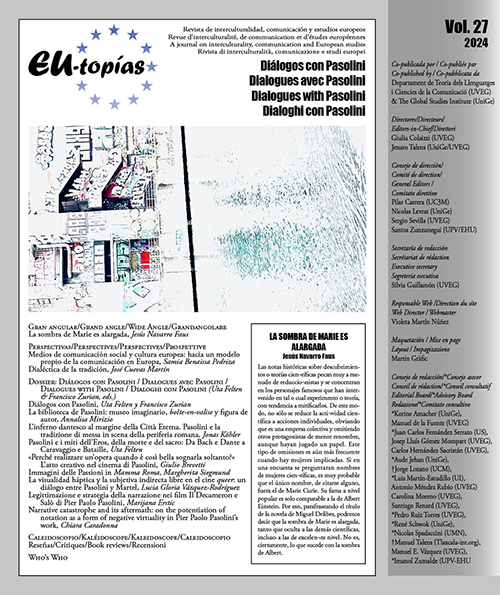Pasolini and the myths of Eros, Death and the Sacred: From Bach and Dante to Caravaggio and Bataille
DOI:
https://doi.org/10.7203/eutopias.27.28593Keywords:
Caravaggio, cinema, corporality, eros, death, Pasolini, Dante, Bataille. Abstract
Abstract
The analysis focuses on Pasolini’s cinema from a mythological and intermedial perspective by studying the procedures of pictorial, musical, literary and philosophical codification in Accattone (1961), Mamma Roma (1962) and Teorema (1968). Thanks to the intermedial approach, the multiple strategies of a mythological codification of the protagonists of the Roman borgata come to light, who become mythological figures of ambiguous valence that oscillate between eros, death and the sacred.
In our analysis of Mamma Roma we show that Caravaggio is not only a pictorial reference but also a spiritual reference, a figure of thinking of ambiguity in the sense of Deleuze. In Pasolini and Caravaggio’s thinking of ambiguity, life and death, Eros and Thanatos, the real and the unreal, the sacred and the profane are like two mirrors endlessly reflecting each other. In the film Teorema, references to Georges Bataille’s concept of the sacralization of Eros come to light.
 Downloads
Downloads
 References
References
Bataille, Georges. Œuvres complètes. T. X. Paris: Gallimard, 1987.
Blumenberg, Hans. Work on Myth. Massachusetts: MIT Press, 1985.
Bonitzer, Pascal. Le champ aveugle. Essais sur le réalisme au cinéma. Paris: Gallimard, 1982.
Chiesi, Roberto. «Pasolini e Caravaggio». Nomads. Mediterranean Perspectives | 05, 2017.
Deleuze, Gilles. Cinéma 2. L’image-temps. Paris: Éditions de Minuit, 1985.
Fusillo, Massimo. La Grecia secondo Pasolini: mito e cinema. Roma: Carocci, 2007.
Gmelin, Hermann: Die göttliche Komödie. Kommentar Teil 2. Der Läuterungsberg. Stuttgart: Klett, 1955.
Groß, Bernhard. Figurationen des Sprechens. Berlino: Vorwerk 8, 2008.
Longhi, Roberto. Caravaggio. Milano: Abscondita, 2013.
Micciché, Lino. Filmologia e filologia. Studi sul cinema italiano. Venezia: Marsilio, 2002.
Monte, Michele di. Pier Paolo Pasolini. Tutto e santo. Il corpo veggente – The Seeing Body. Roma: Gallerie Nazionali di Arte Antica, 2023.
Morin, Edgar. Le cinéma ou l’homme imaginaire. Essai d’anthropologie. Paris: Éditions de Minuit, 1956.
Pasolini, Pier Paolo. Mamma Roma. Milano: Rizzoli, 1962.
Pasolini, Pier Paolo. Il sogno del centauro. Roma: Editori Riuniti, 1983.
Pasolini, Pier Paolo. «La luce di Caravaggio». Saggi sulla letteratura e sull’arte. Milano: Mondadori, 1999, pp. 2673-2674.
Pier Paolo Pasolini. Per il cinema I. Milano: Mondadori, 2001a.
Pier Paolo Pasolini. Per il cinema II. Milano: Mondadori, 2001b.
Spila, Piero. Pier Paolo Pasolini. Roma: Gremese, 2002.
Subini, Tomaso. La necessità di morire: il cinema di Pier Paolo Pasolini e il sacro. Roma: Ente dello spettacolo, 2007.
Witte, Karsten. Die Körper des Ketzers. Berlino: Vorwerk 8, 1998.
Filmografia
Pasolini, Pier Paolo. Accattone, 1961.
Pasolini, Pier Paolo. Mamma Roma, 1962.
Pasolini, Pier Paolo. La ricotta, 1963.
Pasolini, Pier Paolo. Teorema, 1968.
Dipinti
Bernini, Gian Lorenzo di. L’Estasi di santa Teresa d’Avila, 1645-1652.
Bondone, Giotto di. Madonna di Ognissanti, 1310 circa.
Caravaggio, Michelangelo Merisi da. Fanciullo con canestro di frutta, 1593.
Caravaggio, Michelangelo Merisi da. Bacchino malato, 1593-94.
Caravaggio, Michelangelo Merisi da. Crocifissione di San Pietro, 1600.
Caravaggio, Michelangelo Merisi da. Deposizione di Cristo, 1602-03.
Mantegna, Andrea. Cristo morto, 1470-1483 circa.
Downloads
Published
How to Cite
-
Abstract86
-
PDF 26
Issue
Section
License
![]()
The authors conserve the copyright. All content published in EU-topías. Journal of interculturality, Communication, and European Studies are subject to the license Creative Commons Attribution-NonCommercial-ShareAlike 4.0 license. The full text of the license can be found at <http://creativecommons.org/licenses/by-nc-sa/4.0>
They may be copied, used, disseminated, transmitted and publicly displayed, provided that:
- The authorship and original source of the publication is cited (journal, publisher and URL of the work).
- They are not used for commercial purposes.
- The existence and specifications of this license of use are mentioned.
It is the responsibility of the authors to obtain the necessary permissions for images that are subject to copyright.



